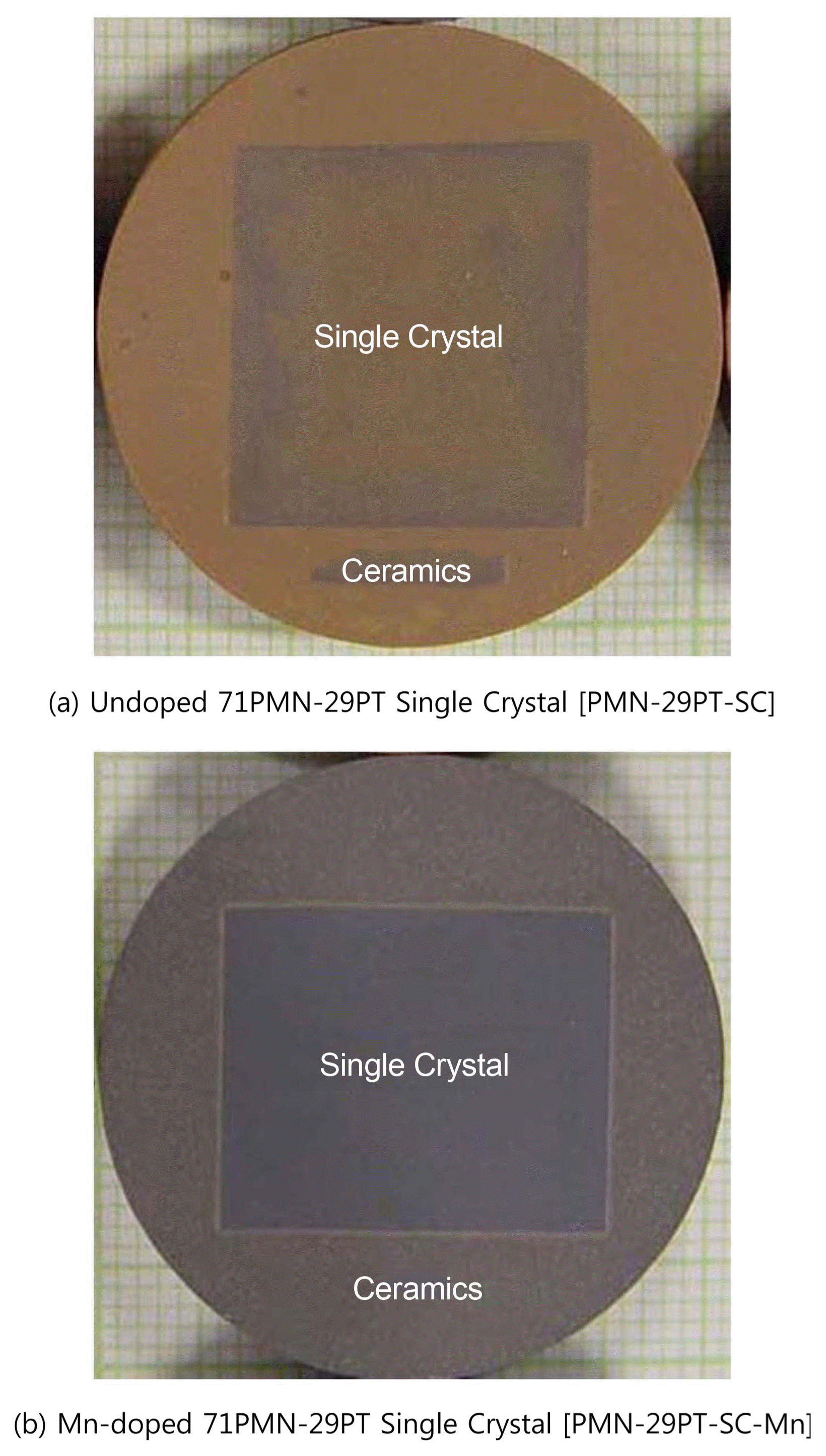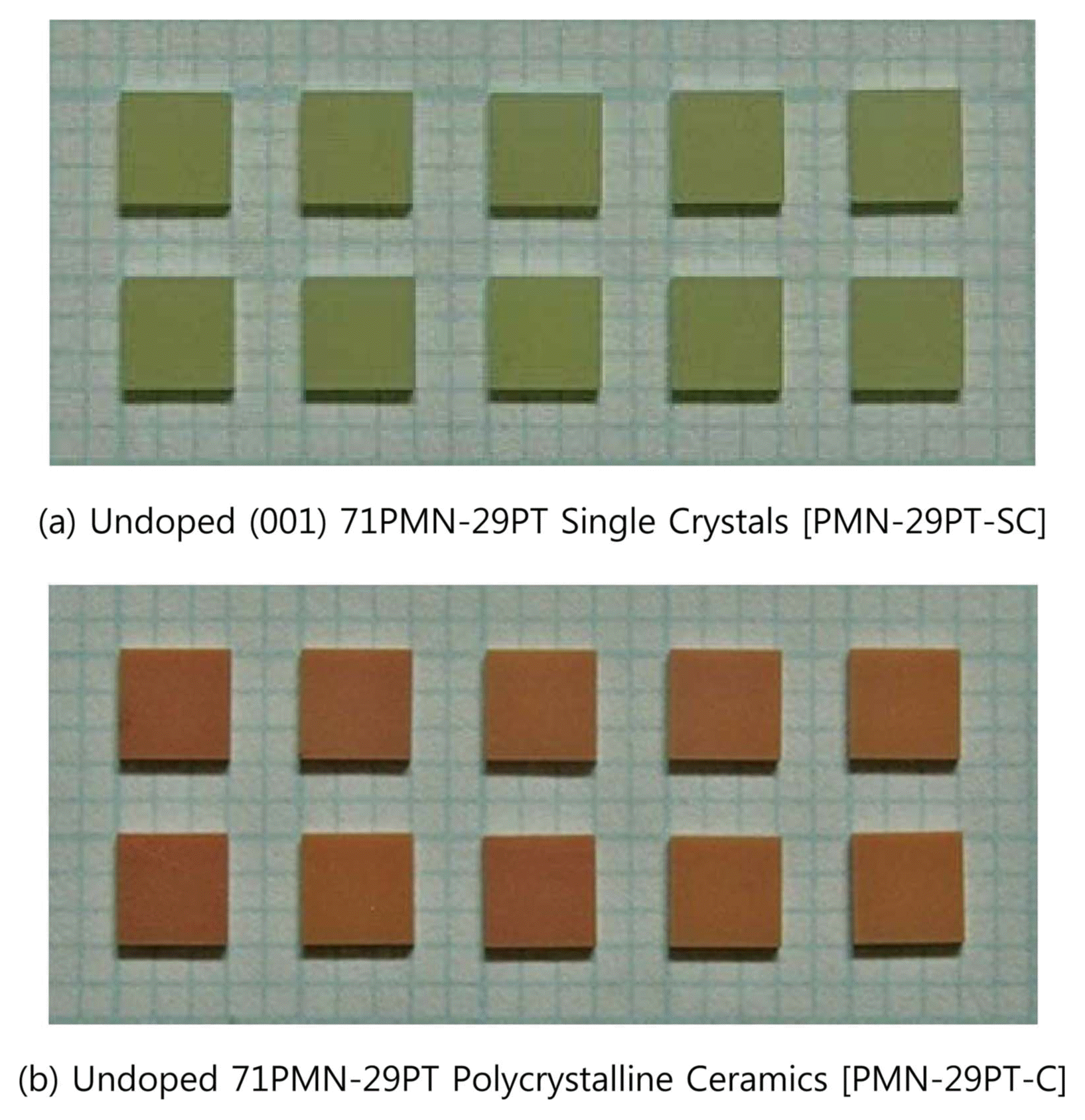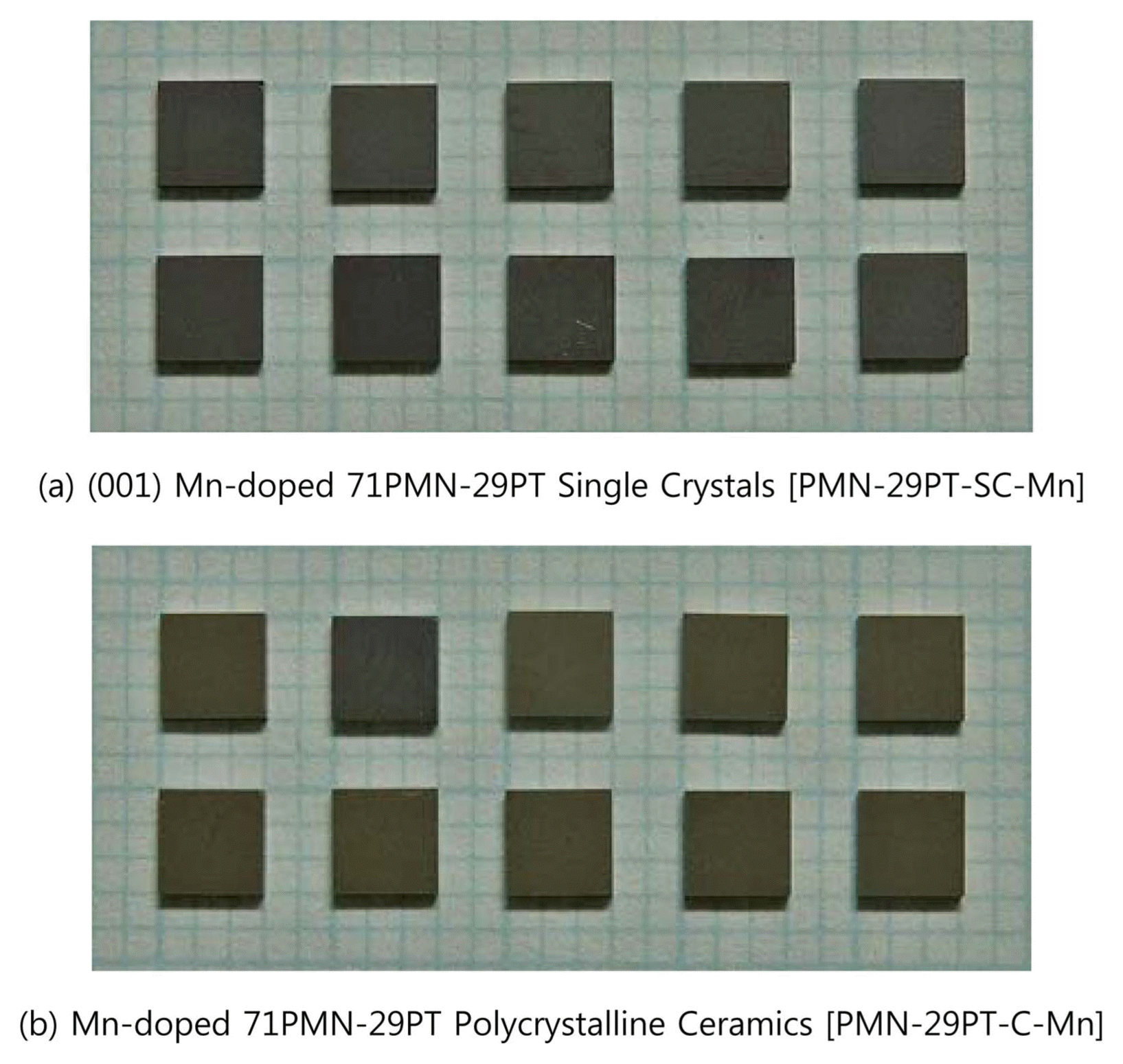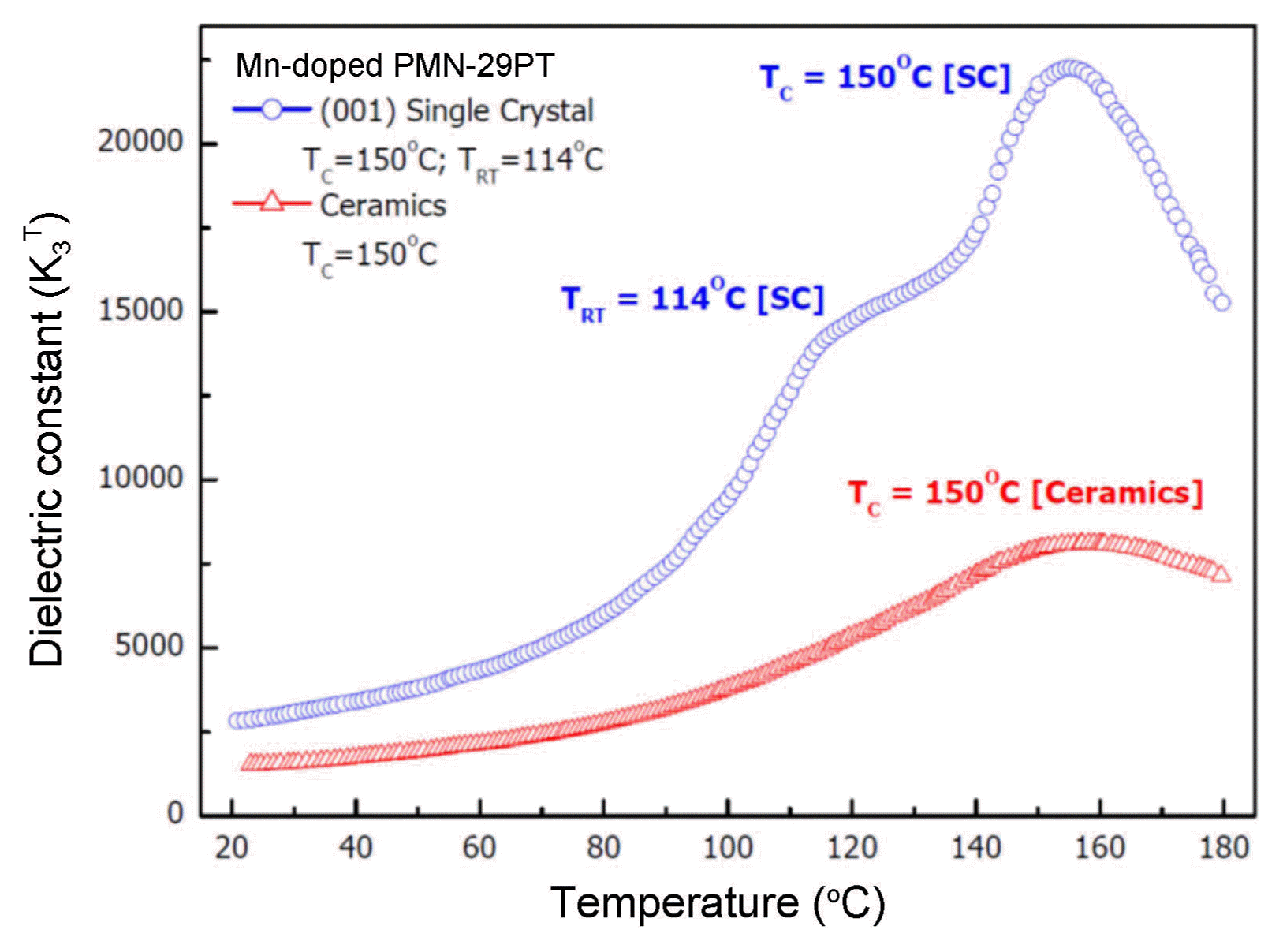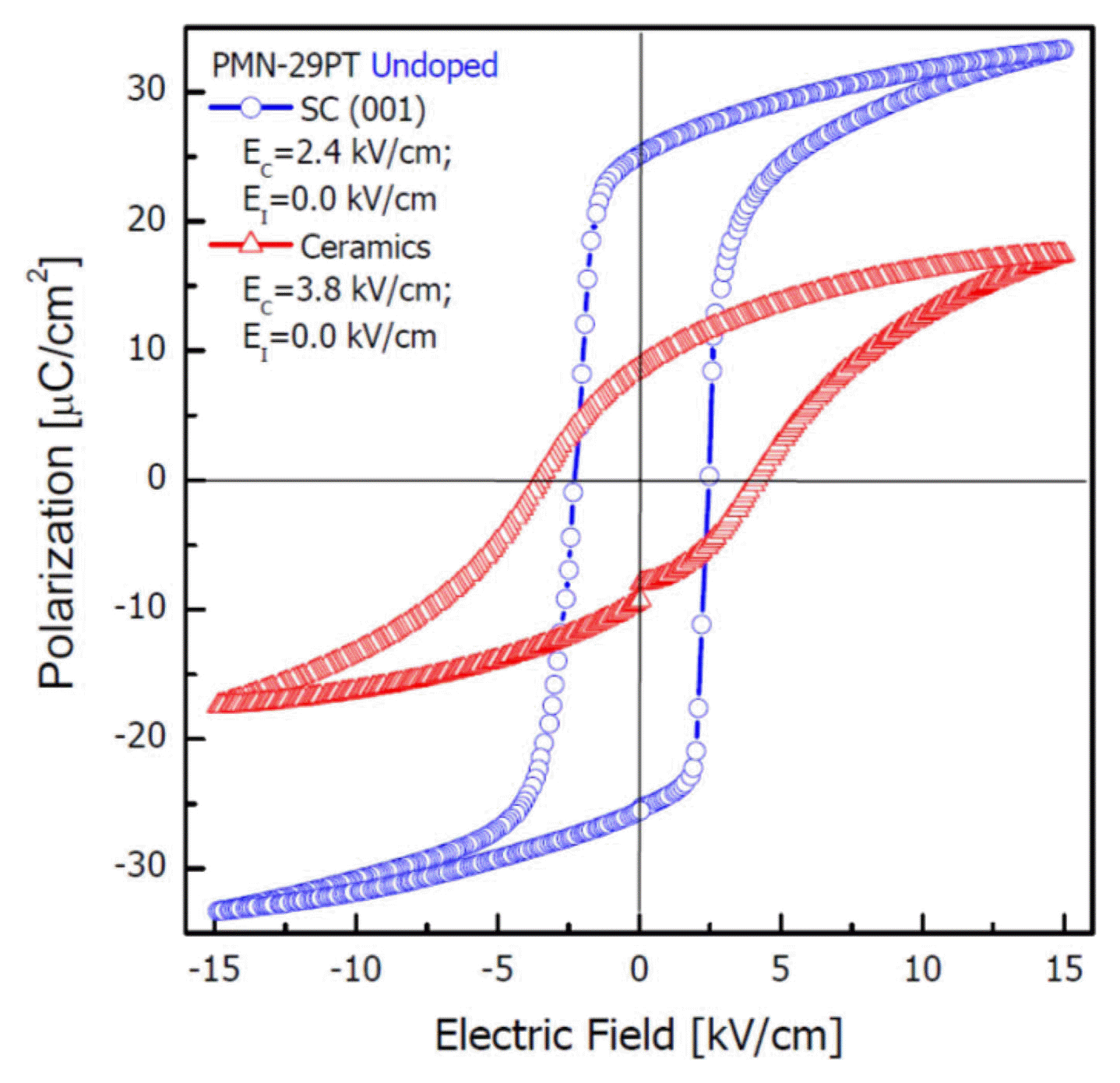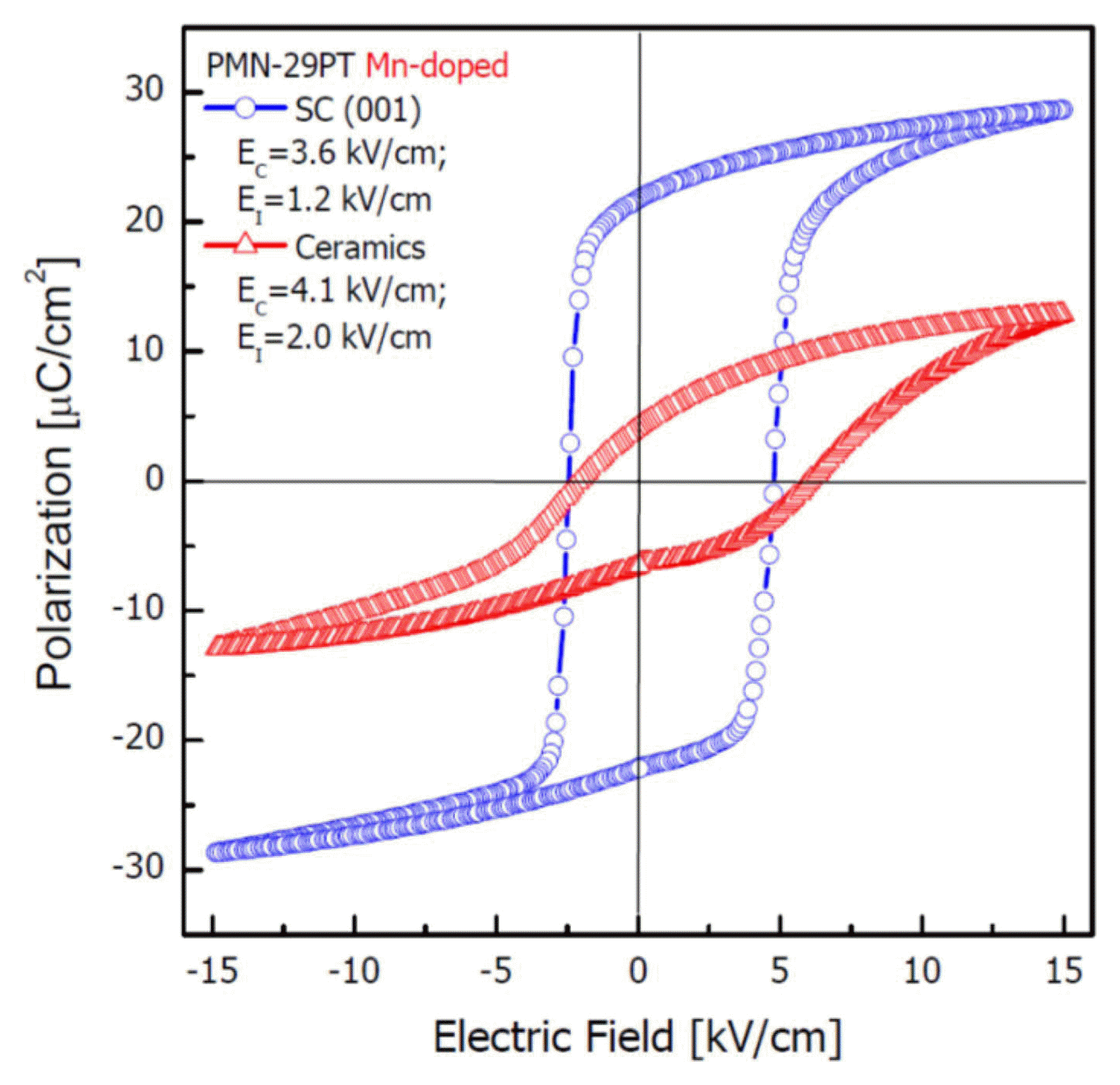1. Introduction
Among piezoelectric materials, the PZT [Pb(Zr,Ti)O3] polycrystalline ceramic developed in the 1950s has been most widely used up to now.1) However, after the development of the PZN-PT [Pb(Zn2/3Nb1/3)O3-PbTiO3] and PMN-PT [Pb(Mg1/3Nb2/3)O3-PbTiO3] piezoelectric single crystals by the research team of Professor Kuwata of the Tokyo Institute of Technology, Japan, in the 1980s, and the research team of Professor Tom Shrout of the Pennsylvania State University, US, in the 1990s, respectively, piezoelectric single crystals have brought about significant changes to the research and market of piezoelectric materials and applications.2-4) Table 1 compares the dielectric and piezoelectric properties of PZT polycrystalline ceramic and PMN-PT single crystal. The PZN-PT and PMN-PT single crystals exhibit piezoelectric charge constants (d33) of greater than 1,500 pC/N and electromechanical coupling coefficients (k33) of greater than 0.9. In particular, comparison of d31 and k31 showed that these values were a maximum of 8 and 2 times greater for the PMN-PT single crystal than those of the PZT ceramic (Table 1).2-4)
Since the development of the PMN-PT piezoelectric single crystal, Philips and Humanscan carried out development of piezoelectric single crystals for application to medical ultrasound imaging systems; currently, piezoelectric single crystal ultrasound imaging systems for medical purposes have been commercialized by Philips, Humanscan, GE, Siemens, and Hitachi.3,4) Also, beginning with medical ultrasound imaging systems, applications in various fields have been attempted, including SONAR transducers, high-intensity focused ultrasound (HIFU), acoustic sensors, piezoelectric actuators, piezoelectric sensors, ultrasonic motors, and piezoelectric energy harvesters.2-4) For the application of PMN-PT piezoelectric single crystals in such various fields, there have been numerous attempts recently to control the dielectric and piezoelectric properties suitable for each application field by introducing additives (donor or acceptor) to the PMN-PT piezoelectric single crystal. Especially, there have been many attempts to add acceptors to PMN-PT piezoelectric single crystals for application to the high power piezoelectric transducers used in underwater SONAR transducers and medical systems. It has been reported that the addition of a donor to the PZT polycrystalline ceramic maximizes the dielectric constant, piezoelectric charge constant, and electromechanical coupling coefficient, while the addition of an acceptor maximizes the internal bias, coercive electric field, and Qm. However, in the case of piezoelectric single crystals, the fabrication of additive (donor or acceptor) added piezoelectric single crystals has been found to be difficult when using the Flux or Bridgman methods, which are the generic single crystal growth methods. So, studying the effects of the additives on piezoelectric single crystals has been challenging.
In this study, the solid-state single crystal growth (SSCG) method was used to fabricate a PMN-PT [Pb(Mg1/3Nb2/3)O3-PbTiO3] piezoelectric single crystal without Mn addition, as well as an Mn added PMN-PT piezoelectric single crystal. Generally, single crystals and polycrystalline ceramics exist together within the specimen after the SSCG process. Thus, one specimen can be cut to simultaneously fabricate (001) plane single crystal and polycrystalline ceramic measurement specimens.5-9) By fabricating the (001) plane single crystal and polycrystalline ceramic specimens with the same chemical compositions and directly comparing the dielectric and piezoelectric properties, the differences between the piezoelectric single crystal and polycrystalline ceramic can be compared directly. Additionally, the effect of Mn addition was investigated for the piezoelectric PMN-PT single crystal and ceramic and the difference in the effect of the Mn addition on the single crystal and polycrystalline ceramic was analyzed. The applicability of Mn added PMN-PT piezoelectric single crystals to high power piezoelectric transducers such as underwater SONAR transducers and medical systems was investigated in comparison to the conventional PZT polycrystalline ceramic and pure PMN-PT piezoelectric single crystal.
2. Experimental Procedure
In this study, a 71PMN-29PT [Pb(Mg1/3Nb2/3)O3-29PbTiO3] piezoelectric single crystal without Mn addition, as well as an Mn added 71PMN-29PT piezoelectric single crystal were fabricated by Ceracomp Co., Ltd. (www.ceracomp.com) using the solid-state single crystal growth (SSCG) method.5-9) Pb3O4 (99.9%, Alfa Aesar, Ward Hill, MA), MgNb2O6 (99.9%, H. C. Starck GmbH, Newton, MA), and TiO2 (99.99%, Ishihara, San Francisco, CA) were the powder raw materials used in this process. After measuring the quantity of each powder ingredient, mixing was carried out for 24 h using the ball milling process; this was followed by drying and calcination at 800°C. The calcinated powders underwent secondary ball milling together with an excess of PbO powder. Then, samples were dried and filtered through a sieve to fabricate the final powder product. This powder was uniaxially hot pressed at high temperature to produce a dense primary sintered body. After the primary sintering, a Ba(Zr0.1Ti0.9)O3 seed single crystal was placed on top of the 71PMN-29PT ceramic sintered body and heat treatment was carried out for solid-state single crystal growth. To prevent loss of PbO, which is volatile, heat treatment for the solid-state single crystal growth was conducted using the double crucible method. During the single crystal growth heat treatment, the Ba(Zr0.1Ti0.9)O3 seed single crystal continuously grew within the 71PMN-29PT polycrystalline ceramic and 71PMN-29PT single crystals with dimensions of 30 × 30 × 5 mm3 were produced. In the SSCG method, composition gradients within the fabricated single crystal were not observed and the product showed chemical uniformity because melting of the 71PMN-29PT phase does not occur in the single crystal fabrication method.
Generally, the grown single crystals and polycrystalline ceramic existed simultaneously within the SSCG process (Fig. 1). Thus, one specimen was cut to simultaneously prepare both the (001) plane single crystal and polycrystalline ceramic measurement specimens. These specimens [3.0 × 3.0 × 0.5(t) mm3] had the same chemical compositions, making it possible to carry out a direct comparison of their dielectric and piezoelectric properties. Sputtering was used to produce Au electrodes on the surface of each measurement specimen. The dielectric and piezoelectric properties of the fabricated piezoelectric single crystal were measured according to the IEEE standards.10,11) Also, the effect of adding Mn was investigated for the piezoelectric 71PMN-29PT single crystal and ceramic. In particular, the effect of Mn addition on the single crystal and polycrystalline ceramic was analyzed.
3. Results and Discussion
3.1. Piezoelectric Single Crystal Fabrication Using the Solid-State Single Crystal Growth(SSCG) Method
Figure 1 shows the (a) 71PMN-29PT [PMN-29PT-SC] piezoelectric single crystal with no Mn addition and (b) Mn added 71PMN-29PT piezoelectric single crystal [PMN-29PT-SC-Mn] both fabricated through the solid-state single crystal growth (SSCG) method. While the 71PMN-29PT single crystal with no Mn added was a bright yellow color, the Mn added 71PMN-29PT single crystal showed a black color. Since SSCG occurs at temperatures below the melting temperature of the polycrystalline ceramic, the shape of the polycrystalline ceramic for the grown single crystal was maintained even after single crystal growth. As a result, the grown single crystal and polycrystalline ceramic existed simultaneously within the specimen after the SSCG process.
3.2. Fabrication of Measurement Specimens
Figure 2 shows the dielectric and piezoelectric property measurement specimens prepared by cutting the piezoelectric single crystal and polycrystalline ceramic regions fabricated using the SSCG method. Since the chemical compositions of the (001) plane single crystal and polycrystalline ceramic specimens prepared from the same specimen are the same, their dielectric and piezoelectric properties could be directly compared. In order to evaluate the dielectric and piezoelectric properties of the PMN-29PT single crystal, specimens were prepared with the shape and dimensions (3.0 × 3.0 × 0.5(t) mm3) shown in Fig. 2. Also, using sputtering, Au electrodes were formed on the surface of the fabricated single crystal and polycrystalline ceramic measurement specimens. The dielectric and piezoelectric properties of the prepared measurement specimens were measured in accordance with the IEEE standards.10,11)
3.3. Dielectric Property Change According to Temperature and Phase Transition Temperature
Changes in the dielectric constant according to the temperature were observed using the measurement specimens shown in Figs. 2 and 3. Specimen permittivities according to temperature were observed and the phase transition temperatures from rhombohedral to tetragonal phase (TRT) and from tetragonal to cubic phase (TC) were measured. Values of TC and TRT of the 71PMN-29PT specimen in Fig. 4 were observed to be 130°C and 92°C, respectively. While the TC of the 71PMN-29PT piezoelectric polycrystalline ceramic was observed to be 131°C, no phase transition temperature corresponding to TRT was observed. In the case of the Mn added 71PMN-29PT (Fig. 5), values of TC and TRT were found to be 150°C and 114°C, respectively. In addition, while the TC of the Mn-PMN-29PT piezoelectric polycrystalline ceramic was observed to be 150°C, no phase transition temperature corresponding to TRT was observed. The observation of the TRT phase transition temperature for the single crystal and lack of observation for the crystalline case, as shown in Figs. 4 and 5, were in agreement with the results of previously reported studies. The phase transition temperature (TC), which is proportional to the chemical composition of the piezoelectric material, was found to be the same for the single crystal and the polycrystal, showing that they also had the same chemical composition.12,13) By adding Mn of about 0.5 mol% to the 71PMN-29PT single crystal, the phase transition temperatures (TC and TRT) showed an increase of about 20°C.
3.3. Polarization and Coercive Electric Field Properties
Using the measurement specimens shown in Figs. 2 and 3, the polarization and coercive electric field (EC) according to the electric field variation, were measured. As shown in Fig. 6, the coercive electric field for the (001) 71PMN-29PT piezoelectric single crystal [PMN-29PT-SC] was 2.4 kV/cm and no internal bias electric field(EI) was observed because the polarization curve was vertically symmetric. Also, EC was 3.8 kV/cm for the 71PMN-29PT piezoelectric polycrystalline ceramic [PMN-29PT-C] and no internal bias electric field was observed. The coercive electric field for the (001) 71PMN-29PT piezoelectric single crystal was approximately 65% of that of the polycrystalline ceramic. The coercive electric field for the Mn added 71PMN-29PT piezoelectric single crystal [PMN-29PT-SC]-Mn was 3.6 kV/cm and the asymmetric polarization curve shifted in the positive electric field direction (Fig. 7). The asymmetry of the polarization curve was due to the occurrence of the internal electric field within the piezoelectric single crystal; the magnitude of the internal electric field was observed to be 1.2 kV/cm.14-16) Also, the coercive electric field of the Mn-PMN-29PT piezoelectric polycrystalline ceramic[PMN-29PT-C-Mn] was 4.1 kV/cm and the internal electric field magnitude was 2.0 kV/cm.
Figure 8 shows the effect of Mn addition according to the polarization property of the (001) 71PMN-29PT single crystal. Due to the Mn addition, the coercive electric field and internal electric field of the 71PMN-29PT single crystal [PMN-29PT-SC-Mn] increased by more than 1.2 kV/cm each. Such internal electric fields are generally observed for hard-type PZT ceramics (PZT-4 and PZT-8) with the addition of acceptors like Mn.14-16) As was the case of PZT, the increase in the coercive electric field for the PMN-29PT-SC-Mn was caused by the occurrence of the internal electric field due to the Mn addition. When an acceptor such as Mn is added to PZT or PMN-PT, Oxygen vacancies are produced and the two defects of the acceptor and oxygen vacancy combine to form defect dipoles. It has been reported that such defect dipoles lead to the generation of the internal electric field within the crystals.15)
The magnitude of the internal electric field has the tendency to be proportional to the electromechanical quality factor (Qm),14) so the internal electric field is necessary for high-power piezoelectric ceramic materials that require a high Qm. Therefore, the Mn-PMN-29PT piezoelectric single crystal [PMN-29PT-SC-Mn], with greater coercive electric field and internal electric field compared to those of the pure 71PMN-29PT piezoelectric single crystal [PMN-29PT-SC], has a larger usable voltage range and is more suitable for high-voltage and high-power operations.14-16)
3.4. Dielectric and Piezoelectric Properties of the Fabricated Piezoelectric Single Crystal and Polycrystalline Ceramic
Table 2 shows the dielectric and piezoelectric property values of the Mn added plate-type (001) 71PMN-29PT single crystal and polycrystalline ceramic without Mn addition. In Table 2(a), the dielectric constant (K3T), dielectric loss (tanδ, %), piezoelectric charge constant (d33), and electromechanical quality factor (Qm) for the (001) 71PMN-29PT single crystal [PMN-29PT-SC] were above 6,140, 0.8%, 1,881 [pC/N], and 100, respectively. In Table 2(b), the dielectric constant (K3T), dielectric loss (tanδ, %), piezoelectric charge constant (d33), and electromechanical quality factor (Qm) for the 71PMN-29PT polycrystalline ceramic [PMN-29PT-C] were above 2,159, 2.5%, 127 [pC/N], and 200, respectively. Compared to those of the 71PMN-29PT polycrystalline ceramic, the dielectric constant and piezoelectric charge constant for the (001) 71PMN-29PT single crystal increased more than 3 and 15 fold, respectively, and the dielectric loss decreased to about 40%.
Table 3 shows the dielectric and piezoelectric property values for the Mn added (001) 71PMN-29PT single crystal [PMN-29PT-SC-Mn] and polycrystalline ceramic [PMN-29PT-C-Mn]. In Table 3(a), the dielectric constant (K3T), dielectric loss (tanδ, %), piezoelectric charge constant (d33), and electromechanical quality factor (Qm) for the (001) PMN-29PT-SC-Mn single crystal were above 3,230, 0.4%, 1,052 [pC/N], and 500. In Table 3(b), the dielectric constant (K3T), dielectric loss (tanδ, %), piezoelectric charge constant (d33), and electromechanical quality factor (Qm) for the PMN-29PT-C-Mn polycrystalline ceramic were 1,464, 0.5%, 100 [pC/N], and 500. Compared to those of the polycrystalline ceramic, the dielectric constant and piezoelectric charge constant for the Mn added (001) 71PMN-29PT single crystal increased more than 3 and 10 fold, respectively, while the dielectric loss was similar.
When the results of Tables 2 and 3 are compared, the effect of adding Mn on the dielectric and piezoelectric properties of the 71PMN-29PT single crystal and polycrystalline ceramic can be observed. In the case of the single crystals, the addition of Mn decreased the dielectric constant (K3T), piezoelectric charge constant(d33), and dielectric loss (tanδ, %) to approximately 50% of the original values. However, the electromechanical quality factor (Qm) increased to about 500%. In the case of the polycrystalline ceramic, the addition of Mn decreased the dielectric constant (K3T) to about 70%, piezoelectric charge constant (d33) to about 80%, and dielectric loss (tanδ, %) to about 20%. However, the electromechanical quality factor (Qm) increased to about 250%. For both the single crystal and polycrystalline cases, adding Mn to 71PMN-29PT significantly decreased the dielectric constant, piezoelectric charge constant, and dielectric loss, while greatly increasing the electromechanical quality factor.
3.5. Comparison of the Dielectric and Piezoelectric Properties of the Fabricated Piezoelectric Single Crystals and Polycrystalline Ceramics
Table 4 shows the dielectric and piezoelectric properties of the generic polycrystalline PZT-5H, PZT-4, and PZT-8 ceramics and the 71PMN-29PT piezoelectric single crystal and ceramic fabricated in this study. Also, the output properties of each piezoelectric material were compared by setting the Figure of Merit (FOM), which represents the characteristics of high-power piezoelectric materials, to “Qm·d33”.8) Each material was compared based on the FOM of the PZT-4 polycrystalline ceramic, which is the most widely used. The FOM of the (001) 71PMN-29PT single crystal [PMN-29PT-SC] without Mn addition was similar to that of the PZT-4 ceramic. However, the electromechanical quality factor (Qm) for the Mn added Mn-71PMN-29PT piezoelectric single crystal[PMN-29PT-SC-Mn] was approximately 5 times higher than that of the pure 71PMN-29PT single crystal. This high electromechanical quality factor (Qm) caused the FOM of the Mn-71PMN-29PT piezoelectric single crystal to be more than 5 times greater than the FOM of the 71PMN-29PT single crystal and PZT-4 ceramic. The results showed that the addition of Mn to the piezoelectric single crystal is necessary for high-power applications.
4. Conclusions
In this study, dielectric and piezoelectric property changes due to Mn addition were investigated for the 71PMN-29PT [Pb(Mg1/3Nb2/3)O3-29PbTiO3] piezoelectric single crystal and polycrystalline ceramic. In the case of single crystals, the dielectric constant (K3T), piezoelectric charge constant (d33), and dielectric loss (tanδ, %) decreased to around 50% of their original values, while the coercive electric field (EC) and electromechanical quality factor (Qm) increased to 150% and 500%, respectively. When Mn was added within the PMN-PT, it was found that an internal bias electric field (EI) was first induced, which then transformed the piezoelectric material from a piezoelectrically soft to piezoelectrically hard state. As the dielectric and piezoelectric properties of the polycrystalline ceramic were lower than those of the single crystal, the effect of Mn addition was relatively smaller than it was for the polycrystalline ceramic case. The Mn added 71PMN-29PT piezoelectric single crystals clearly showed properties of a piezoelectrically hard type material. Compared to the pure 71PMN-29PT single crystal, the Mn added 71PMN-29PT single crystal had a wider usable temperature and voltage range and high-power output, making it applicable for high-power piezoelectric transducers used in underwater SONAR transducers and medical systems.









